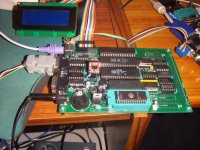Exact CPLD implementation varies between vendors, but a fairly typical device and the way it works is the
Xilinx XC9500 series. This a 5V series of CPLDs that can be had in 44 and 84 pin PLCC packages (they'll go into a socket with 0.100 lead spacing). Altera offers a similar 5V family
the MAX 7000 series.
Newer devices are 3.3V, rather than 5V and tend to be offered in surface-mount packaging only.
Hi Chuck! Thanks!
A hobbyist could easily use the N8VEM system to create a CPLD peripheral in 0.100" lead spaced packages (DIP, PLCC, PGA). Just use the existing and available ECB prototyping board to mount the device. There are a bunch of compatible devices at Digikey using 5V which would require minimal interfacing and even 3.3V devices if one used a local regulator onboard. I think it would be ideal for educational purposes and I have been advocating the N8VEM project for education since the beginning.
At least at first, you could just use power and ground and physically mount the device on the ECB prototyping board and use JTAG or whatever interface it has. Directly interface a CPLD to the ECB it would require about 11 IO pins I think assuming; a chip select, a /WR signal, a register select (A0), and 8 data lines. It could probably be done in fewer if needed. Especially using the 68 pin PLCC or larger packages they certainly have enough pins left to be useful. Alternatively, one could use a 8255 as an interface between the CPLD and the ECB. There are many options!
I like the 28, 40, 44, and 68 pin devices since those are really easy to work with as wire wrap sockets are available. Depending on how its interfaced, using a since CPLD would leave most of the 4"x4" prototyping area left for whatever else the builder wants to include. One N8VEM builder is doing exactly this right now to interface a Propeller chip. The Propeller is more of a microcontroller than programmable logic device but a similar approach could be used to easily interface a CPLD to the ECB.
The same probably applies to FPGA devices in the 44, 68, and 84 PLCC packages especially the 5V compatible versions. Digikey has several in stock from FPGA manufacturers. I supposed the PGA packages as well although the problem with larger sizes is there aren't wire wrap sockets available (although you could make your own using machine pin SIP sockets) and current draw gets to be problematic at larger sizes. I'd bet that all the PLCC packages are practical though.
The N8VEM system is intended to be a platform for expansion with home brew peripherals. It is easily done. I have built several peripherals and builders are making more all the time. Just recently some builders are making a keyboard display front panel like device and more are on the way.
All through the N8VEM home brew project development I've kept the hobbyist in mind using low cost, reliable, and easily assembled components. I'll agree its not the most advanced or powerful system available but every builder I know of who has started their system has finished with a working system -- usually on the first try. Having the CP/M environment is free, simple, and familiar enough to use right away.
Yes, you could use a PC or another prototype board but where is the fun in that?

There are some people I'll never convince and that's OK. For those who'll listen I'd like to encourage hobbyists to build on what's already available N8VEM home brew system there rather than start from scratch. It is a *lot* easier to leverage an existing system and may have long term benefits that'll continue to help the community when it's done.
Thanks and have a nice day!
Andrew Lynch, 73 de N8VEM
PS, I just ordered PCBs for the N8VEM 6809 host processor board and they should be available soon. The only software that runs on it at the moment is hacked version of the Motorola MiniBug. Further development of the 6809 side of N8VEM would make a great hobbyist project. There are some 6809 operating systems and applications freely available like FLEX and CUBIX just waiting to be ported.

